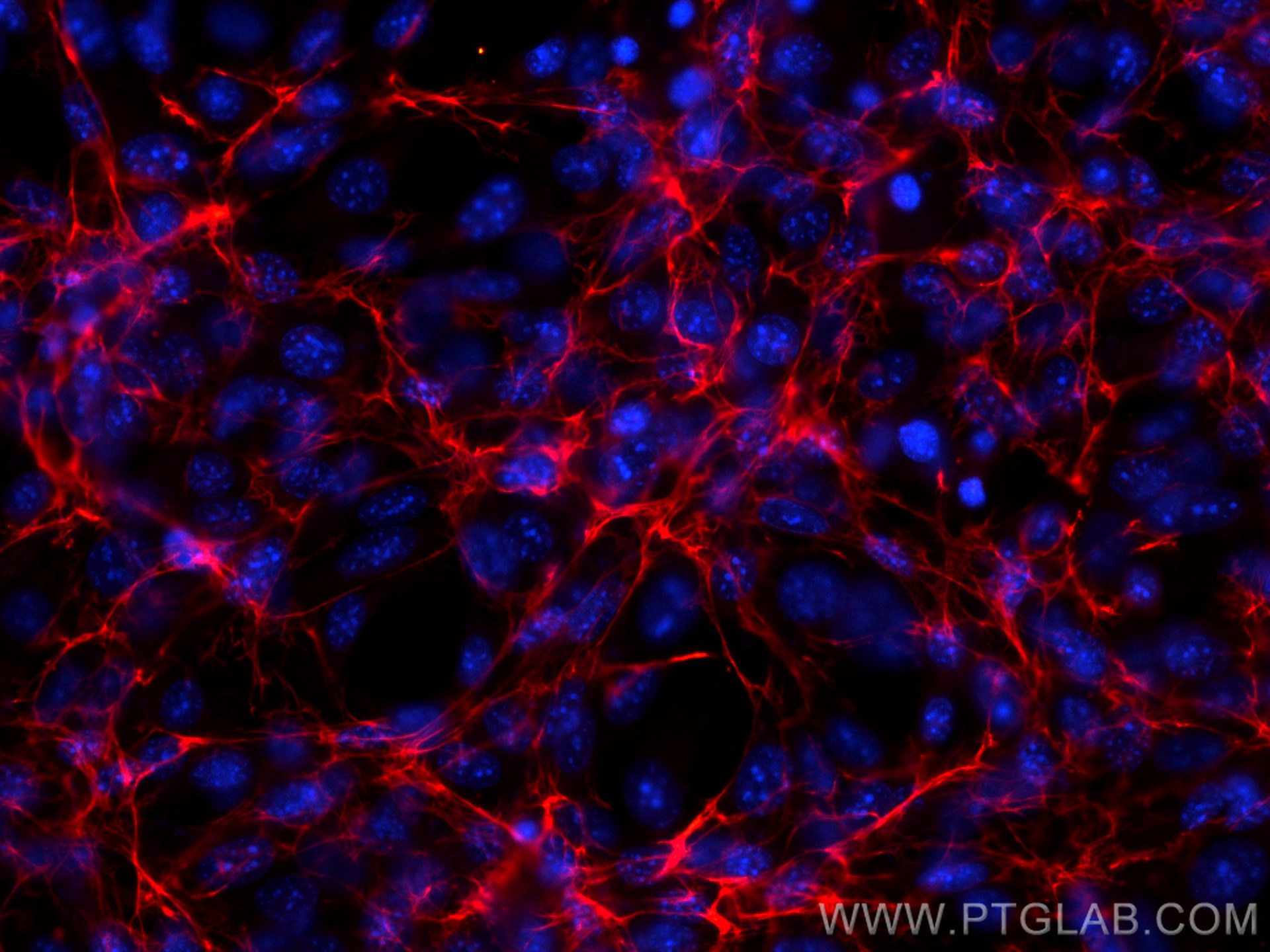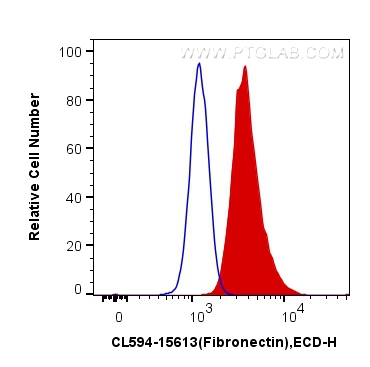验证数据展示
经过测试的应用
| Positive IF/ICC detected in | NIH/3T3 cells |
| Positive FC (Intra) detected in | NIH/3T3 cells |
推荐稀释比
| 应用 | 推荐稀释比 |
|---|---|
| Immunofluorescence (IF)/ICC | IF/ICC : 1:50-1:500 |
| Flow Cytometry (FC) (INTRA) | FC (INTRA) : 0.40 ug per 10^6 cells in a 100 µl suspension |
| It is recommended that this reagent should be titrated in each testing system to obtain optimal results. | |
| Sample-dependent, Check data in validation data gallery. | |
产品信息
CL594-15613 targets Fibronectin in IF/ICC, FC (Intra) applications and shows reactivity with human, mouse samples.
| 经测试应用 | IF/ICC, FC (Intra) Application Description |
| 经测试反应性 | human, mouse |
| 免疫原 |
CatNo: Ag8004 Product name: Recombinant human FN1 protein Source: e coli.-derived, PGEX-4T Tag: GST Domain: 2177-2386 aa of BC005858 Sequence: DQQRHKVREEVVTVGNSVNEGLNQPTDDSCFDPYTVSHYAVGDEWERMSESGFKLLCQCLGFGSGHFRCDSSRWCHDNGVNYKIGEKWDRQGENGQMMSCTCLGNGKGEFKCDPHEATCYDDGKTYHVGEQWQKEYLGAICSCTCFGGQRGWRCDNCRRPGGEPSPEGTTGQSYNQYSQRYHQRTNTNVNCPIECFMPLDVQADREDSRE 种属同源性预测 |
| 宿主/亚型 | Rabbit / IgG |
| 抗体类别 | Polyclonal |
| 产品类型 | Antibody |
| 全称 | fibronectin 1 |
| 别名 | FN1, Anastellin, CIG, Cold insoluble globulin, Cold-insoluble globulin |
| 计算分子量 | 2386 aa, 263 kDa |
| GenBank蛋白编号 | BC005858 |
| 基因名称 | Fibronectin |
| Gene ID (NCBI) | 2335 |
| RRID | AB_2919822 |
| 偶联类型 | CoraLite®594 Fluorescent Dye |
| 最大激发/发射波长 | 588 nm / 604 nm |
| 形式 | Liquid |
| 纯化方式 | Antigen affinity purification |
| UNIPROT ID | P02751 |
| 储存缓冲液 | PBS with 50% glycerol, 0.05% Proclin300, 0.5% BSA, pH 7.3. |
| 储存条件 | Store at -20°C. Avoid exposure to light. Stable for one year after shipment. Aliquoting is unnecessary for -20oC storage. |
背景介绍
Fibronectins play a role in cell adhesion, motility, wound healing, and the maintenance of cell shape. Fibronectins bind to cell surfaces via interactions with integrins and various molecules such as collagen, fibrin, heparin, DNA, and actin (PMID: 3326130). Cellular interaction with fibronectin (FN1) promotes cell cycle progression and proliferation by influencing cyclins.
What is the molecular weight of FN1?
The molecular weight of FN1 is 220 kDa.
What is the tissue specificity of FN1?
FN1 is a large glycoprotein that exists in both a soluble form in plasma (plasma FN1) and other body fluids and an insoluble form in the extracellular matrix (cellular FN1) (PMID: 21923916). Plasma FN1, or the dimeric form, is secreted by hepatocytes, whereas cellular FN1, the dimeric or cross-linked multimeric form, is produced by fibroblasts and epithelial cells and deposited as fibrils in the extracellular matrix.
What are the post-translational modifications of FN1?
FN1 is often sulfated and its C-terminal NC1 peptide, anastellin, is produced as a result of proteolytic processing and can inhibit tumor growth, angiogenesis, and metastasis by activating p38 MAPK and inhibiting lysophospholipid signaling (PMID: 11209058).
What is FN1's role in embryogenesis?
Fibronectin has a crucial role in the development of the left-right body axis during embryogenesis (PMID: 21466802).
What is FN1's involvement in disease?
Fibronectin glomerulopathy is a kidney disease that eventually leads to end-stage renal disease and is caused by mutations in the FN1 gene. Mutations in FN1 lead to the production of abnormal fibronectin protein that is deposited in the glomeruli of the kidney (PMID: 18268355).
实验方案
| Product Specific Protocols | |
|---|---|
| FC protocol for CL594 Fibronectin antibody CL594-15613 | Download protocol |
| IF protocol for CL594 Fibronectin antibody CL594-15613 | Download protocol |
| Standard Protocols | |
|---|---|
| Click here to view our Standard Protocols |



